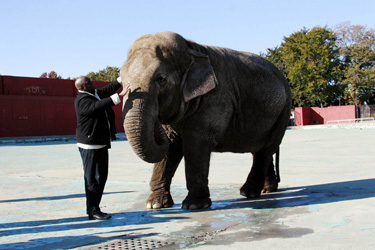Javier Téllez, Production still from Letter on the Blind For the Use of Those Who See, 2007.
Born 1969 in Valencia, Venezuela; lives in New York, New York
Video installation artist Javier Téllez’s films combine documentary with fictionalized narratives to question definitions of normality and pathology. Collaborating with institutionalized patients living with mental illness to rewrite classic stories or invent their own, he creates what he calls a cinematic “passport to allow those outside to be inside” by renegotiating sociocultural barriers. This approach to using art as a voice for the marginalized positions itself within the tradition of art therapy, though Téllez attempts to “cure” viewers of false assumptions, rather than the patients of their disorders. Circus tents and other props provide ironic references to historically carnivalesque exploitations of abnormality, epitomized in director Tod Browning’s films. In contrast, Tellez’s projects assert the individualism and competence of his actors and emphasize their human dignity by engaging their creativity on sophisticated intellectual levels. Working intimately with his casts, Téllez blurs distinctions between artist and patient to consider the arbitrary boundaries of reality, reason, and insanity.
Made for inSite_05 in San Diego, California, and Tijuana, Mexico, One Flew Over the Void (Bala Perdida) (2005) documents Téllez’s “self-organized circus” of patients from Mexicali’s CESAM mental health center, who, wearing animal masks and carrying handmade signs, walked in protest against general views on mental illness in today’s society. The procession culminated at the site of a performance in which human cannonball David Smith was shot over the Mexico-U.S. border to critique current immigration policy. Combining two disparate political concerns, Téllez’s film takes issue with larger notions of exclusion. Bright color footage of patients marching and playing horns, interspersed with shots of Smith’s audience, suggest humor and celebration as healing alternatives to isolation, segregation, and racism. In the last sequence, entitled “Circus Performers,” participants remove their masks for individual facial close-ups, the pleasure they experienced from the event obvious.
Téllez’s 16mm film Letter on the Blind For the Use of Those Who See (2007), premiering at the 2008 Whitney Biennial, extends his interest in otherness into the realm of the physically disabled. The artist re-created the Indian parable “The Blind Men and the Elephant,” filming six blind people as they touch different parts of a live elephant and editing their “moments of tactile recognition” to coincide with their descriptions of what they feel. Shot inside Brooklyn’s disused McCarren Park swimming pool, this piece contemporizes the ancient narrative’s lesson that every being experiences the same thing in a unique way. His desire to encourage broad, compassionate thinking is reiterated by his employment of the strange architecture. By offering linguistic and visual space for the eloquent expressions of those typically relegated to silence, Téllez diminishes our differences as a means to transformation. TRINIE DALTON
Javier Téllez, Production still from Letter on the Blind For the Use of Those Who See, 2007. 16mm film transferred to high-definition video, color, sound; 27:36 min.. Collection of the artist; courtesy Peter Kilchmann Galerie, Zurich. Commissioned by Creative Time, New York, as part of Six Actions for New York City, co-produced by Peter Kilchmann Galerie, Zurich
























